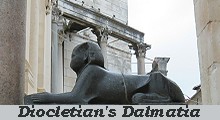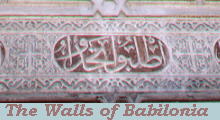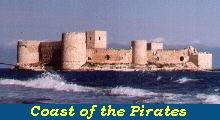

What's New!
Detailed Sitemap
All images © by Roberto Piperno, owner of the domain. Write to romapip@quipo.it. Text edited by Rosamie Moore.
Page added in April 2015.
|

 - Phaselis - Phaselis
(theatrical masks at Myra)
You may wish to read an introduction to this section first.
Sea resort at Kemer
Phaselis was situated on the western side of the Gulf of Antalya which is characterized by high mountains close to the coastline.
In the late 1970s the first tourist facilities of this region were built at Kemer, a small town north of Phaselis. Today many very large sea resorts line up for miles and miles. They cater for all tastes, including those of Amsterdam's commuters who miss their Central Railway Station.
Southern harbour with Tahtali Dagi (2,362 mt/7,760 ft) in the background (photo taken on January 7, 2015); (inset) aerial cableway station on Tahtali Dagi
On a small peninsula, at the foot of
Takhtalu, are the remains of the city of
Phaselis, with its three ports and lake, as
described by Strabo. (..) The principal port was formed by a stone pier, at the southern side of the
isthmus; it projected about two hundred yards into the sea, by which it has been
entirely overthrown, and can now only
be traced underwater.
Francis Beaufort, Captain of HMS Frederikssteen, a frigate of 32 guns: Karamania; or a brief description of the South Coast of Asia Minor, and of the Remains of Antiquity collected during a survey of that coast, under the orders of the Lords Commissioners of the Admiralty, in the years 1811 & 1812 - Published in 1817
In summer so many sunbathers come to Phaselis by boat from the nearby resorts, that authorities have opened a ticket office on the pebble beach of the ancient southern harbour. Sunbathers go snorkelling around its submerged wharf. In winter the harbour is a very quiet place and it shows all its natural beauty with the snow on the mountains adding to it.
Silted lake/northern harbour; it recalls the harbour of Patara
Phaselis stood on a headland which created three natural harbours of different size. The northern harbour was most likely used for military purposes as it was less visible from the sea. Phaselis was founded in the VIIth century BC most likely by seamen from Rhodes. In the Ist century BC it became a base of the pirates who attacked ships on their way between Syria and Greece.
Middle harbour. Kemer and its many sea resorts are situated beyond the cape shown in this image
The two other ports were on the northern side; one of
them is very small, with a narrow entrance in the pier, where it seems to have
been closed by gates. F. Beaufort
This harbour was most likely used by small fishing boats because of its shallow waters. There is evidence that, similar to the northern harbour, its mouth was closed by a chain laid between towers standing on now sunken rocks. In 1972 Phaselis was included in a National Park which protects the coastline and its mountains from a point south of Kemer to Cape Gelidonya at the end of the Gulf of Antalya.
(above) Main square with entrances to the agora (left) and to small baths (right); (below) portal of an enlargement of the agora bearing an inscription celebrating Emperor Domitian
The distance between the middle harbour and the southern one is very short and a wide straight street linked the two harbours. A square at its middle was the centre of the town with tribunals, baths and shops. Along the street and in the square statues were erected to worthy citizens. By and large, the ruins of Phaselis are dated Ist and IInd century AD, a period of great wealth in most parts of the Roman Empire.
(above) Bases of the Arch of Hadrian and street leading from the southern harbour to the main square; (below) inscriptions making reference to Emperors Hadrian (left) and Trajan (right)
Emperor Hadrian, accompanied by his wife Vibia Sabina and a small retinue, landed at the southern harbour of Phaselis in the course of a long journey across many provinces of the Empire. The citizens of the town celebrated the event by erecting an arch at the beginning of the main street. The arch has fallen,
but many sections of its dedicatory inscription and fragments of the decoration are scattered nearby. Other inscriptions dedicated to Hadrian have been found in the agora. In one of them the Emperor was celebrated as "Saviour of the World".
Theatre
The headland ends with a rocky hill, which was fortified. There is limited evidence of its walls because the headland, upon which the town stood, consists of a soft rock which easily yields to the action of the sea.
The cliffs fall in as they become unsupported (..). We may consequently presume, that the town and
the peninsula must have once extended
beyond their present limits. F. Beaufort
A small theatre was built into the slope of the hill near the main square and it was enlarged/rebuilt in the IInd century AD. It could seat an audience of 2,000.
Caldaria (hot rooms) in the Great (left) and Small (right) Baths
A large bath complex with an adjoining gymnasium has been identified in a series of buildings along the main street near the middle harbour. A second smaller complex was situated between the main square and the theatre.
The best preserved sections of the baths are their hypocausti (heat from below), low chambers under the caldaria where hot air flowed from a nearby furnace.
Aqueduct
The baths (and some fountains) were supplied by an aqueduct which carried water from a spring to the north of the town. It was presumably built in the Ist century AD and its remaining arches are the first thing one sees of Phaselis when coming by land.
Sarcophagus near the northern harbour
Tombs were built outside the town enclosure and fragments of sarcophagi can be seen here and there in the pinewood north of the town and along the seashore.
Phaselis is recorded as a bishopric see in the Vth century and again in the VIIIth century. It was most likely raided by the Arabs and after the Seljuk conquest of the region in the XIIth century it was abandoned.
(left) Bases of statues with lengthy inscriptions at the agora; (right) decorative motifs at the southern harbour
The image used as background for this page shows a decorative motif on a broken lintel.
Introductory page
Priene
Miletus
Didyma
Iasos
Euromos
Milas
Kaunos
Telmessos
Tlos
Xanthos
Letoon
Patara
Antiphellos
Simena
Myra
Termessos
Perge
Side
Aspendos
Antalya
Map of Turkey with all the locations covered in this website

SEE THESE OTHER EXHIBITIONS (for a full list see my detailed index).
  
|